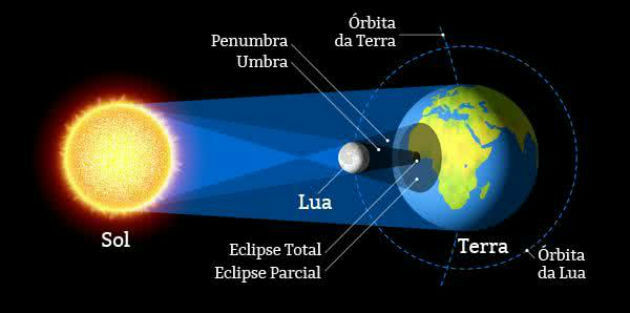The solar eclipse is a rare phenomenon that happens when the Moon is located between planet Earth and the Sun. In this position, the Earth is covered by a shadow.
Eclipses of the Sun in 2021
In 2021 there will be two solar eclipses: one annular and one total, none of which will be visible in Brazil.
The annular eclipse occurs on the day June 10 and can be seen in North America, Europe and Asia. In day December 4th it will be the turn of a total solar eclipse, which can be seen in Antarctica, Africa and the Atlantic.
In Brazil, the forecast is that a total solar eclipse will only be visible in 2045.
How does it happen and for what duration?
The eclipse of the Sun only occurs at times when the Moon is in its new phase.
It does not always occur, as the Earth and Moon orbits differ in their positions and shapes.
This is because the planet Earth's orbit around the Sun is not in the same plane as the Moon's orbit around the Earth.

It is interesting to note that if there were no inclination between the planes of the orbits, eclipses would be a common phenomenon. Thus, there would be a lunar eclipse every full moon and a solar eclipse every new moon.
The phenomenon lasts for a maximum of 7 minutes. The solar eclipse that occurred on January 15, 2010 (Annular Eclipse of the Sun) was considered the longest eclipse in the millennium. It lasted for 11 minutes and 7.8 seconds.
How to see the eclipse?
Visualizing the eclipse phenomenon with the naked eye is not recommended, as the radiation emanating from the Sun can burn the eye tissue.
Also do not wear sunglasses, veiled films, X-rays. Binoculars or telescopes can only be used with the use of special filters for this purpose. The ideal is not to overdo the observation.
Experts recommend that the observation be done for just a few seconds and with the use of specific glasses. Goggles used for soldering can be a safe option as long as their shade is greater than 14.
Of the types of eclipses that exist, the most harmful to view with the naked eye is a partial solar eclipse. That's because the Sun's brightness remains practically the same.
Eclipse Types
The shadow cast by the Moon, which hits some point on the surface of planet Earth, determines the disappearance of the Sun.
According to the way it is visible, the eclipse is classified as follows:
Total Eclipse: Occurs when the Sun is completely covered by the Moon, blocking all sunlight. A total eclipse of the Sun takes about 400 years to be repeated in the same place on planet Earth.
Partial Eclipse: occurs when only a part of the Sun is covered by the Moon, partially blocking the Sun's luminosity.
Annular Eclipse or ring: it occurs because the angular diameter of the Moon is smaller than the diameter of the Sun, so that the satellite (Moon) can only cover the center of the solar disk, forming a bright ring.
Hybrid Eclipse: In this case, depending on where it is observed, the eclipse can be either ring or total.
In the animation below, we see part of the trajectory of the Moon's shadow on the Earth's surface caused by the total solar eclipse that occurred on August 21, 2017.
Solar Eclipse and Lunar Eclipse
A solar eclipse occurs when the Moon is between the Earth and the Sun. O lunar eclipse, in turn, occurs when the Earth is between the Moon and the Sun, that is, when the Moon penetrates the Earth's shadow.
Solar eclipses occur in the new moon phase, while lunar eclipses occur in the full moon phase. At these moments, the Sun is on a meeting line between the plane of the lunar orbit and the solar orbit called the "Line of Nodes".
Generally speaking, eclipses occur four times a year (two solar and two lunar).
